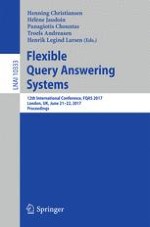2017 | Book
Flexible Query Answering Systems
12th International Conference, FQAS 2017, London, UK, June 21–22, 2017, Proceedings
Editors: Henning Christiansen, Hélène Jaudoin, Panagiotis Chountas, Troels Andreasen, Henrik Legind Larsen
Publisher: Springer International Publishing
Book Series : Lecture Notes in Computer Science
